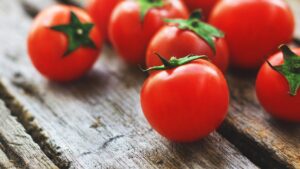- The tomato is native to South America. One species, Solanum lycopersicum, was transported to Mexico where it was grown and consumed by Mesoamerican civilizations, like the Mayans, who developed the larger furrowed fruits.
- Aztecs and other peoples in the region used the fruit in their cooking; it was cultivated in southern Mexico and probably other areas by 500 BC. The exact date of domestication is not known.
- The word “tomato” comes from the Nahuatl word ‘tomatl’, literally “the swelling fruit”.
- Tomato was first described in a herbal in 1544 by Pietro Andrea Mattioli as a new type of eggplant, brought to Italy with red or golden colour. Ten years later the tomato was named ‘pomi d’oro’ or ‘golden apple’. Many European countries took this as inspiration and named them with gold names, such as the German ‘goldapfel’. The French were also convinced tomatoes were aphrodisiacs and named them “love apples.”
- After the Spanish colonization of the Americas, the Spanish distributed the tomato throughout their colonies in the Caribbean, then to the Philippines from where it spread to Southeast Asia and later the entire Asian continent.
- Cultivated tomatoes vary in size, from tomberries, about 5 mm in diameter, through cherry tomatoes, about the same 1–2 centimetres (0.4–0.8 in) size as the wild tomato, up to beefsteak tomatoes, 10 centimetres (4 in) or more in diameter.
- The Guinness World Record for “most tomatoes harvested from a single plant over one year” was 32,194 tomatoes harvested between May 2005 and April 2006, and the plant weighed 522.464 kg.
- Believe it or not, but tomatoes have travelled to outer space. As part of the ‘Tomatosphere I, II, III and IV’ experiments, 600,000 tomato seeds went to the International Space Station before being grown in classrooms all over Canada. This was set up to get a better understanding of the effect of outer space on seed growth and development.
- Processed tomatoes are the richest source of lycopene available to us naturally. Lycopene is a very powerful antioxidant and studies suggest that people who eat a lot of tomato products have a lower risk of cancer of the lungs, prostate, and stomach. Watermelon, pink grapefruit, and fresh tomatoes are also good sources of lycopene.
- According to the UPOV database, there are currently over 20,000 tomato varieties that have been registered for National Listing, and a little over 5,000 tomato applications have been filed for plant breeders’ rights.
- What do you know, tomatoes are not always red! It is true, most tomato varieties produce red fruit, but varieties with yellow, orange, pink, purple, green, brown, black, or white fruit are also available. There are also varieties that are multi-coloured or have striped fruits.
- According to the FAO, in 2019 around 181 million tons of tomato were produced, with China in the no. 1 position with 35% of the total, followed by India, EU and Turkey as major producers (see table).
| Top Tomato Producers in 2019 | |
| Numbers in Million tonnes | |
| China | 62.8 |
| India | 19.0 |
| EU (UK not included) | 16.5 |
| Turkey | 12.8 |
| USA | 10.9 |
| Egypt | 6.9 |
| Iran | 5.2 |
| Mexico | 4.3 |
| Brazil | 3.9 |
| Nigeria | 3.8 |











